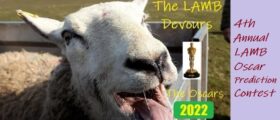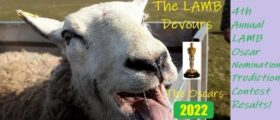Editor’s note: This is part of a 32-part series dissecting the 85th Academy Awards, brought to you by the Large Association of Movie Blogs and its assorted members. Every day leading up to the Oscars, a new post written by a different LAMB will be published, each covering a different category of the Oscars. To read the other posts regarding this event, please click here. Thank you, and enjoy!
By Natalie of Natalie Stendall Film Blog
Beasts Of The Southern Wild is one of those rare films that completely carries its audience away. When I saw it for the first time back in October, I was captivated and found myself thinking about it more often than any other film I’d seen all year. From start to finish, Benh Zeitlin’s debut feature runs deep with emotion and an unexpected truthfulness that makes his audience feel so much. For me, Zeitlin’s film is what the Academy Award for Best Picture should be all about.
For those of you who haven’t seen it yet, Beasts Of The Southern Wild is a beautiful and poetic apocalypse tale, as seen through the eyes of a child.
Six year old Hushpuppy (Quvenzhane Wallis) lives with her Dad, Wink (Dwight Henry), in a Louisiana Bayou community known as the Bathtub. While they live a life of abject poverty in ramshackle shanty houses, cluttered with livestock and recycled belongings, their sense of identity – as independent, resourceful and distinctly separate from mainland America, whose authorities seek to force them out of their home – is fierce and compelling.
Zeitlin presents life in the Bathtub as simultaneously bleak and glorious. Wink is seriously ill, but refusing all of the help medicine can offer him. Instead, he raises Hushpuppy harshly, in preparation for a time when he will gone. Here Beasts Of The Southern Wild reaches the height of its poignancy, confronting the struggles of life and the inevitability death. In parallel to the threat placed on Wink and Hushpuppy’s relationship, the Bathtub is struck by a powerful storm which threatens to annihilate their small community.
Loaded with subtext, Beasts Of the Southern Wild is a heady, earthy gumbo, bubbling fiercely with themes and metaphors. This complex world is presented to us through the eyes of Hushpuppy, our boisterous and imaginative narrator. Ideas about her community, mythical tales of pre-historic Auroch’s and an understanding of nature’s careful balance are blended together in her young and curious mind. In placing Hushpuppy at the centre of the story, Beasts Of The Southern Wild, tackles ideas found in more convoluted works, such as Terrence Malick’s The Tree Of Life, in an instantly appealing and accessible way. Hushpuppy’s succinct truths are humbling and eye-opening as she tells us, ‘The whole universe depends on everything fitting together just right. If one piece busts, even the smallest piece, the entire universe will get busted’. When the storm hits, Hushpuppy’s prophecy appears to have come true and, as her assertions are intercut with brief clips of crumbling ice caps, Beasts Of The Southern Wild delivers an environmental message that is both palatable and powerful.

This positioning of Hushpuppy’s perspective at the centre of the film is a clever move by Lucy Alibar, who adapts her play Juicy And Delicious with Zeitlin for the big screen. Despite her forthright nature, Hushpuppy’s vulnerable position allows us to make our own judgements about life in the Bathtub. Although it has received some criticism for skirting serious issues about poverty, Beasts Of The Southern Wild is neither critical of, nor does it advocate, Wink’s parenting efforts. Hushpuppy’s own thoughts and actions are enough to suggest that she is much too young to deal with the pressures placed upon her – cooking herself a meal, Hushpuppy lights the stove with a blow torch in a scene that is both amusing and terrifying. Yet Hushpuppy’s community has a positive attitude, a respect for nature and an innate understanding of its intricate balance that forces us to question our own lives.
For all his tough love, Wink’s vague explanations about what happened to Hushpuppy’s mother – we are told that ‘she swam away’ – demonstrates his innermost desire to shelter her from harsh realities. These childhood stories feed into Hushpuppy’s magical view of the world and the film takes an interesting turn as Hushpuppy embarks on her own courageous adventure.
The strength of the performances from Quvenzhane Wallis and Dwight Henry (both first time performers) propels Beasts Of The Southern Wild forward with genuine feeling. Wallis is the youngest Academy Award nominee for Best Actress and deservedly so. Her energy and unrestrained spirit breathe resolute, determined life into Hushpuppy, giving us a realistic and deeply courageous character. Dwight Henry, sadly missing out on an Academy Award nomination for Supporting Actor, likewise delivers raw and compelling feeling in his emotionally intense debut.

Cinematographer Ben Richardson beautifully captures Hushpuppy’s intoxicating world, brimming with a childlike curiosity. Richardson’s attention to detail makes Beasts Of the Southern Wild an invigorating sensory experience. Every shot is suffused with nature. From airborne views of the Bayou, to pouring rain and the onslaught of the storm – which we experience entirely from the inside of Hushpuppy’s rattling home – the Bathtub feels enticingly real. Simple shots of melting ice caps are visually arresting while every inch of Zeitlin’s mise-en-scene captures the ramshackle, recycled hardship of life in the Bathtub. In a choice that reflects the film’s fantasy and sense of adventure, Richardson opts not for a predictable palette of depressing grey but, instead, for pure light and a warm glow that ooze celebration and triumph.
The magic of Beasts Of The Southern Wild is communicated in no small part by its details. The emotional score from Zeitlin and Dan Romer, with its folklorish strings and triumphant brass, transports us into Hushpuppy’s world through all its elation and sadness. And, as Hushpuppy lifts a chick to her ear, listening to the animal’s heartbeat, we are treated to the most effortlessly cute cinematic moment of the year. That this is also one of the most imbued with meaning, is telling of Zeitlin’s skill as a director.
Zeitlin’s commitment to his debut feature is impressive, with his credits covering direction, writing and original score, but is Beasts Of The Southern Wild likely to win this year’s Oscar for Best Picture? Despite its magic, I suspect Beasts Of The Southern Wild might just be a little too off-beat to take the trophy, with the more widely screened Lincoln, Argo or Zero Dark Thirty being a much safer bet.
Yet, for me at least, Beasts Of The Southern Wild triumphs in originality and the unexpected. It’s rare today for a film to feel quite unlike anything we’ve seen before but, thanks to Zeitlin’s unusual style, this is exactly what Beasts Of The Southern Wild achieves. Sprinkled with fantasy, Beasts Of The Southern Wild defies categorisation and is so filled with emotion that it lingers in the memory long after the credits roll. Even if it doesn’t win, let’s hope that ‘in a million years from now’ people will remember that ‘once there was a Hushpuppy and she lived with her Daddy in the Bathtub’.







Excellent review.